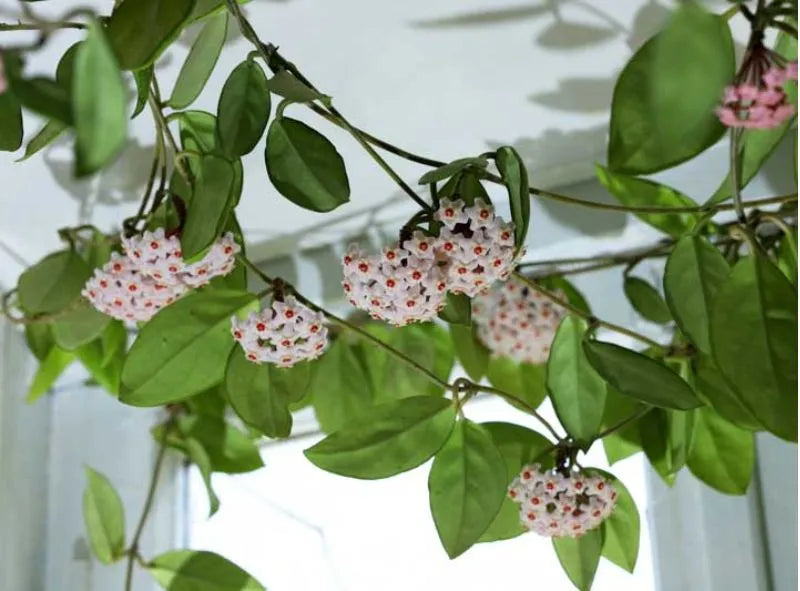- ☀️Light
Thrives in bright, indirect light. May benefit from a few hours of direct sunlight depending on the species.
- 💧Watering
Water every 1 to 2 weeks, allowing the soil to dry out between waterings. In winter, reduce watering frequency.
- 🤒Signs of a sad plant
Leaf spots on leaves: too much exposure to the sun
Yellowing leaves: over watering
- ❤️🩹Easy to keep alive
❤️🩹❤️🩹❤️🩹❤️🩹/5
🪴Today we're talking about Hoyas! (not our products;))
These houseplants have become extremely popular and for good reason. With their succulent leaves and delicate flowers, Hoyas add a little something extra to any home.
Find out how to grow and propagate them successfully.
Hoyas, also known as wax plants, are relatively easy to grow and propagate, and they produce pretty, fragrant flowers.
Here's everything you need to know about caring for your Hoyas.
Popular Hoya Varieties
When you go to a garden center or plant store (probably right after reading this article, in fact), you will usually find three to five different species of Hoya.
However, there is great diversity within this plant.
For example, Hoya carnosa is one of the most commonly grown species and there are many varieties of this plant.
The Hoya carnosa compacta , for example, has thick, succulent leaves that twist and curl in intricate ways, adding interesting texture to your plant collection.
The Hoya carnosa crimson , on the other hand, stands out with its slightly red stems and variegated leaves, creating an attractive visual contrast.
The number of Hoya species varies according to sources. There is often talk of 300 to 400 species , but discussions with collectors and botanists suggest that there could be between 600 and 700 .... To be continued...
This uncertainty is explained by the lack of documentation and the different collection methods around the world. Some species may appear identical but turn out to be different once in flower.
Habitat and growing conditions
Hoyas are native to subtropical and tropical regions, especially Australia. They grow between sea level and 1,000 meters above sea level, in environments where humidity and temperature are relatively stable.
Some high altitude species are more difficult to grow at home due to their specific temperature and humidity requirements.
Species like Hoyas carnosa, Hoyas multiflora, Hoyas bella and Hoyas pubicalyx are easier to grow indoors because they thrive in conditions similar to those you would create at home, with moderate humidity and a stable room temperature. So this is the one we recommend to decorate your living room with a Hoya.
Light and placement
Initially, it is easy to think that Hoyas prefer bright, direct light because of the succulent nature of their leaves. However, most Hoyas naturally grow under tree canopies and prefer bright, indirect light.
So it's best to place them in a location with indirect light, such as an east-facing window, rather than directly south.
Too much light can burn their delicate leaves, while too little light can stunt their growth and reduce their flowering.
Growth Structure of Hoyas
Hoyas have different growth structures .
For example, Hoya carnosa tends to twine around supports like a trellis, making it an excellent climbing plant for vertical spaces.
Others, like Hoya multiflora, have a bushier, more upright growth habit, making them ideal for growing in pots on shelves or windowsills.
Hoya bella, with its thin stems and small leaves, is perfect for hanging baskets where its stems can drape gracefully.
Finally, species like Hoya cumingiana have an erect growth before leaning over, creating quite an interesting visual effect.
The ideal potting soil mix
Hoyas are epiphytic plants , meaning they grow on other plants and need a well-draining potting mix. A good mix is one-third cactus mix, one-third perlite for aeration, and one-third orchid mix.
This type of soil allows Hoyas to dry out quickly between waterings, which is essential for their health. Perlite and orchid mix add aeration, preventing the soil from becoming compacted and ensuring that the roots receive adequate oxygen.
Propagation of Hoyas
The most common method of propagation is by cuttings . Stems can be rooted in water or in sphagnum moss. Thick, fleshy stems often root more quickly in water, while those rooted in sphagnum moss adapt better to soil substrate.
To propagate your Hoyas , you can cut a stem and place it in water or sphagnum moss. The nodes on the stem will begin to produce roots, and once well rooted, the cutting can be transplanted into a suitable potting mix.
When using sphagnum moss, make sure it remains slightly moist but not soggy. This allows the roots to develop without rotting.
Propagation in water is also effective, you will see roots forming along the nodes after a few weeks.
Once the roots are well developed, transplant the cutting into a pot with the recommended potting soil mix.
Fertilization and care
Fertilizing Hoyas is done primarily during the growing season, which is spring , summer, and fall.
You can use our Orchid Nourishing Serum , which is designed especially for epiphytic plants .
When Hoyas begin to bud, this serum can be used to stimulate flowering.
Add a few drops of our serum to the watering water, once every 2 waterings, during its growth period. This will allow better rooting, as well as better flowering.
Post-Propagation Care
After propagating your Hoyas, place the cuttings in a small pot with your potting soil mix. Hoyas prefer small, tight pots because their roots like to grow in confined spaces.
Repot your Hoyas every two to three years to renew the soil without necessarily increasing the size of the pot.
When repotting, inspect the roots for health and remove any rotten or damaged areas. Good drainage is essential, so make sure the pot has adequate drainage holes.
Place the pots in a bright location but without strong direct light to help the cuttings thrive.


